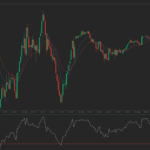Gold swung between gains and losses in a calm trading session on Wednesday as investors weighed an earlier-than-expected deceleration of Feds monetary stimulus against increased physical demand.
On the Comex division of the New York Mercantile Exchange, gold futures for delivery in September traded at $1 321.10 per troy ounce at 8:16 GMT, up 0.05% on the day. Prices held in range between days high and low of $1 324.60 and $1 315.40 an ounce respectively. The precious metal fell 0.9% on Tuesday following the U.S. retail sales data, trimming current weeks advance to 0.6% after gaining 0.19% the preceding week.
Gold fluctuated on Wednesday and traded in a narrow range as investors remained cautious ahead of the upcoming key U.S. data this week that will provide further information of the U.S. economys recovery pace and fuel or dampen speculations over trimming bond purchases. Yesterday, the U.S. Commerce Department reported that U.S. retail sales rose for a fourth straight month by 0.2% in July but underperformed expectations for a 0.3% surge. June’s advance received an upward revision to 0.6% from 0.4%. Meanwhile, Core Retail Sales (Retail Sales less Autos) exceeded projections for 0.4% jump and gained 0.5% in July, while June’s reading was reassessed to 0.1% from a no-change state.
On Wednesday, producer prices (Producer Price Index) will likely show a slower advance than the preceding period both year-on-year and month-on-month. Thursday’s consumer inflation (CPI) should have advanced by 0.2% compared to June and 2.0% from a year earlier. Industrial Production is expected to have surged 0.3%, marking the same advance as in June. Both of Friday’s Building Permits and Housing Starts are projected to have advanced last month.
The dollar index, which measures the greenbacks performance against six major peers, traded at 81.82 at 8:16 GMT, up 0.04% on the day. Futures held in range between days high and low of 81.88 and 81.75 respectively. The September contract settled 0.43% higher on Wednesday, boosted by the rise in retail sales and extended its current weeks advance to 0.8%. Dollar-denominated commodities tend to trade inversely to the dollar as strengthening of the greenback makes them more expensive for foreign currency holders and reduces their appeal as an alternative investment.
Physical demand
Gold was supported amid increased physical demand in China and increased imports curbs in India as a measure to reduce its record-high current account deficit.
China’s gold consumption surged 54% in the first half of the year, putting the country back on track to becoming the world’s biggest bullion consumer. The China Gold Association said earlier in the week that consumption rose by 54% to 706.36 tons in the first half of the year, marking a significant advance after the first quarter’s 26% jump. Bullion purchases rose by 87% to 278.81 tons, while jewelry surged 44% to 383.36 tons.
Current leader is India but the country is expected to curb imports to below 845 tons this year as a measure to narrow its current account deficit. India raised taxes on gold and platinum imports for the third time this year, from 8% to 10%, while the tariff for silver inbound shipments was increased from 6% to 10%. Meanwhile, the Reserve Bank of India made it mandatory in July for shippers to make 20% of the shipments available for re-export as jewelry.
Haresh Soni, New Delhi-based chairman of the All India Gems & Jewellery Trade Federation, said for Bloomberg: “Smuggling of gold will increase and the organized industry will be in disarray. Goods will be kept unofficially and the situation will be uncontrollable. Jewelry prices will rise.”
Apart from the demand side, dollar-priced commodities have largely been tracking shifting expectations for when Fed will begin winding down its monetary easing program as an exit from the stimulus will boost the dollar and reduce the need to invest in raw materials as a hedge strategy.
Xia Yingying, an analyst at Nanhua Futures Co., said for Bloomberg: “Investors are likely to stay cautious ahead of the Fed’s meeting next month as any signs of stimulus withdrawal is bearish for gold. Buying activity in Asia has been robust, with demand in China supporting gold above $1,300. There are still people out there who will buy when the price falls.”
According to a Bloomberg survey this month, 65% of the polled economists expect Fed to begin deceleratiнг its bond purchasing program after FOMCs September meeting, compared to 50% in July. First wave of cuts should be of $10 billion, analysts said.





